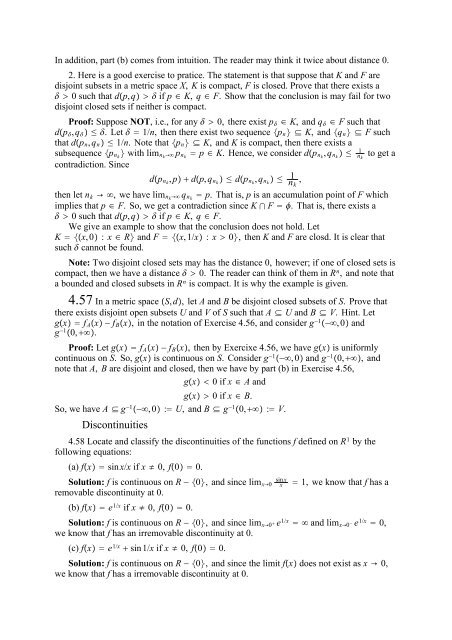The Real And Complex Number Systems
The Real And Complex Number Systems
The Real And Complex Number Systems
You also want an ePaper? Increase the reach of your titles
YUMPU automatically turns print PDFs into web optimized ePapers that Google loves.
In addition, part (b) comes from intuition. <strong>The</strong> reader may think it twice about distance 0.<br />
2. Here is a good exercise to pratice. <strong>The</strong> statement is that suppose that K and F are<br />
disjoint subsets in a metric space X, K is compact, F is closed. Prove that there exists a<br />
0 such that dp, q if p K, q F. Show that the conclusion is may fail for two<br />
disjoint closed sets if neither is compact.<br />
Proof: Suppose NOT, i.e., for any 0, there exist p K, andq F such that<br />
dp , q . Let 1/n, then there exist two sequence p n K, andq n F such<br />
that dp n , q n 1/n. Note that p n K, andK is compact, then there exists a<br />
subsequence p nk with lim nk p nk p K. Hence, we consider dp nk , q nk n 1 k<br />
to get a<br />
contradiction. Since<br />
dp nk , p dp, q nk dp nk , q nk n 1 , k<br />
then let n k , wehavelim nk q nk p. Thatis,p is an accumulation point of F which<br />
implies that p F. So, we get a contradiction since K F . That is, there exists a<br />
0 such that dp, q if p K, q F.<br />
We give an example to show that the conclusion does not hold. Let<br />
K x,0 : x R and F x,1/x : x 0, then K and F are closd. It is clear that<br />
such cannot be found.<br />
Note: Two disjoint closed sets may has the distance 0, however; if one of closed sets is<br />
compact, then we have a distance 0. <strong>The</strong> reader can think of them in R n , and note that<br />
a bounded and closed subsets in R n is compact. It is why the example is given.<br />
4.57 In a metric space S, d, letA and B be disjoint closed subsets of S. Prove that<br />
there exists disjoint open subsets U and V of S such that A U and B V. Hint. Let<br />
gx f A x f B x, in the notation of Exercise 4.56, and consider g 1 ,0 and<br />
g 1 0, .<br />
Proof: Let gx f A x f B x, then by Exercixe 4.56, we have gx is uniformly<br />
continuous on S. So,gx is continuous on S. Consider g 1 ,0 and g 1 0, , and<br />
note that A, B are disjoint and closed, then we have by part (b) in Exercise 4.56,<br />
gx 0ifx A and<br />
gx 0ifx B.<br />
So, we have A g 1 ,0 : U, andB g 1 0, : V.<br />
Discontinuities<br />
4.58 Locate and classify the discontinuities of the functions f defined on R 1 by the<br />
following equations:<br />
(a) fx sin x/x if x 0, f0 0.<br />
sinx<br />
Solution: f is continuous on R 0, and since lim x0 x 1, we know that f has a<br />
removable discontinuity at 0.<br />
(b) fx e 1/x if x 0, f0 0.<br />
Solution: f is continuous on R 0, and since lim x0<br />
e 1/x and lim x0<br />
e 1/x 0,<br />
we know that f has an irremovable discontinuity at 0.<br />
(c) fx e 1/x sin 1/x if x 0, f0 0.<br />
Solution: f is continuous on R 0, and since the limit fx does not exist as x 0,<br />
we know that f has a irremovable discontinuity at 0.
















